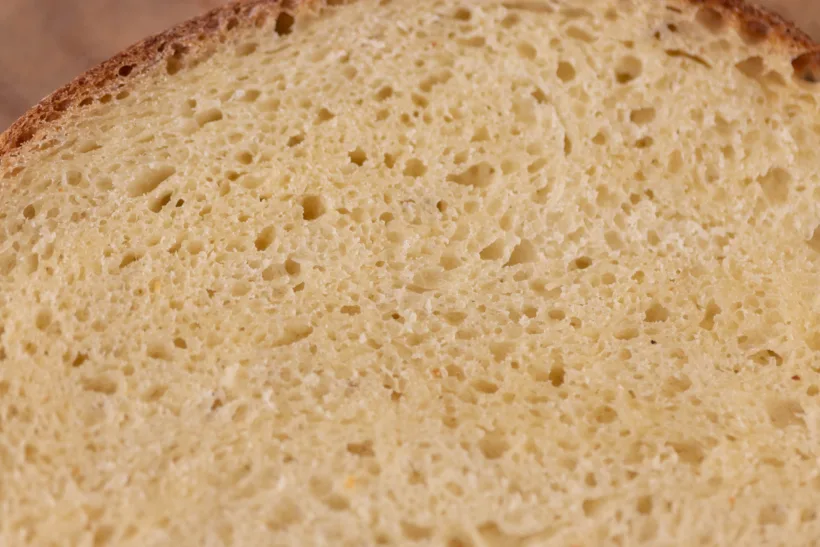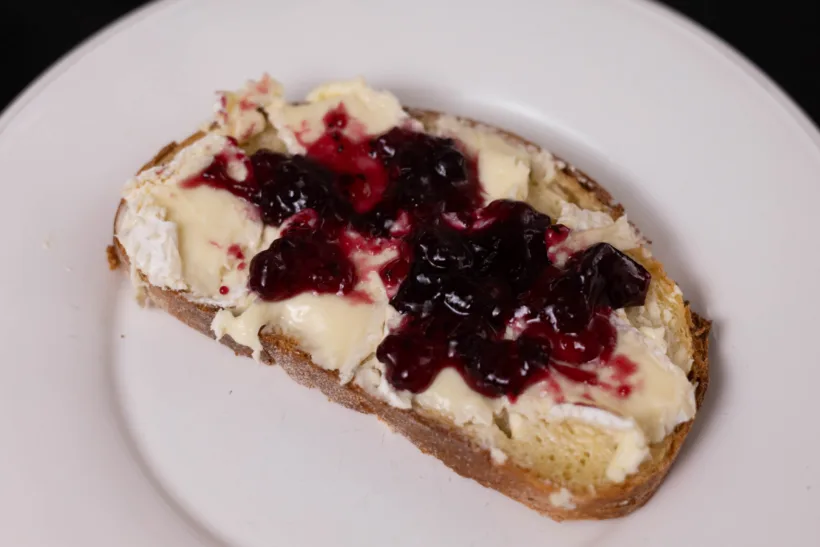Are you looking to bake bread that not only tastes divine but also boasts a picture-perfect golden crust, you’ve come to the right place? Semolina flour, renowned for its slightly sweet, nutty flavor, elevates this bread to a gourmet level. Whether you’re a seasoned baker or just starting out, this recipe promises a delightful baking experience and an even more delightful end product. This is my semolina bread recipe.
While I usually make my bread recipes with mainly bread flour, I feel like it’s time to shine a light on a different flour, namely semolina flour. While bread flour mainly serves as a base for great bread, gaining flavor from added flour, semolina flour boasts a gorgeous taste all by itself. It is a bit sweet and nutty, and it gives the bread such a stunning yellow hue. It’s worth a deeper study, and that’s why we’re here today.

If you are just here for the recipe, you can press the button underneath to be automagically transported to the recipe:
Jump to Recipe Jump to VideoThe history of semolina bread
Semolina bread, with its rich history and unique characteristics, has been a staple in various cultures for centuries. Semolina, derived from durum wheat, has a high protein and gluten content. The gluten lends a distinctive texture and flavor to the bread. Mediterranean and Middle Eastern cuisines most notably use this type of flour, dating back to ancient times. In Italy, bakers have used semolina for centuries to make pasta, and traditional Italian baking methods trace its use in bread. In countries like Morocco and Algeria, semolina is a key ingredient in traditional breads like Khobz and Msemen).
The process of milling durum wheat to produce semolina has evolved over the years. Originally, bakers used labor-intensive stone mills for the process, which modern milling techniques have largely replaced. Despite this, the fundamental properties of semolina have remained the same, contributing to its enduring popularity in bread making. Historically, people often associate semolina bread with artisanal baking. It was a symbol of special occasions due to its rich texture and flavor.

Semolina Bread in modern times
In the US, the popularity of semolina bread surged in the late 20th century with the rise of artisanal bakeries. There has also been a growing appreciation for Mediterranean cuisine. Semolina bread was known for its golden crust and slightly sweet, nutty flavor, making it a favorite among American consumers. This shift also brought a renewed interest in traditional baking techniques and the use of high-quality ingredients like semolina.
Today, semolina bread is celebrated for its versatility and is used in various culinary applications beyond traditional loaves. It’s found in everything from sandwich bread to specialty rolls. It is often enhanced with ingredients like sesame seeds, herbs, and olive oil. This bread blends ancient baking traditions with modern cuisine’s diverse cultural influences.
The history of semolina bread is a testament to the enduring appeal of traditional baking methods. Its evolution from stone mills to modern ovens shows a blend of tradition and innovation, making it a global kitchen staple.

How does semolina flour differ from bread flour?
Finely milled semolina flour, derived from durum wheat, differs significantly from bread flour in several aspects of bread making. First, semolina’s higher protein content than bread flour contributes to a stronger gluten network, resulting in a chewier texture.
Additionally, the finer grind of semolina flour creates a smoother dough, offering a different mouthfeel compared to the coarser texture of bread flour-based bread. In terms of flavor, semolina imparts a distinct, slightly sweet, and nutty taste, which is less pronounced in bread flour.
The yellow hue of semolina, due to its carotenoid content, gives the bread a unique golden color, unlike the pale crumb of bread flour loaves. Semolina’s gluten structure also retains moisture differently, often leading to bread that stays fresh longer. Lastly, semolina flour’s composition demands a slightly altered hydration ratio in recipes, requiring adjustments compared to standard bread flour recipes.
The dough in this semolina bread recipe
Vitals
| Total weight | 1016 grams |
| Pre-fermented flour | 16.7% |
| Hydration | 66.7% |
| Yield | 1 semolina bread |
The dough
This dough is made using a biga, which is a pre-ferment. It works as a sourdough starter by fermenting part of the flour before adding it to the main dough, which helps give it an amazing taste.
| Weight | Ingredient | Baker's Percentage |
|---|---|---|
| 100g | semolina flour, finely milled | 100% |
| 1g | instant yeast | 1% |
| 100g | water | 100% |
You simply make the main dough with a bit of yeast, salt, water, and finely milled semolina flour. The hydration is around 66%, making it a pretty easy dough to work with. The salt content is the usual, at 2% of the flour weight. The bread can take more salt, so if you are not on a dietary restriction, you could easily take it to 2.5% or 3%.

| Weight | Ingredient | Baker's Percentage |
|---|---|---|
| 5g | instant yeast | 1% |
| 10g | fine salt | 2% |
| 300g | water | 60% |
| 500g | semolina flour, finely milled | 100% |
If you want to play around with the formula, change hydration, quantity, or many other things, you can do that in my Bread Calculator.
The conclusion of this semolina bread recipe
This easy semolina bread recipe is a straightforward guide to creating a unique and flavorful bread. The use of semolina flour gives this bread a distinct taste and a beautifully golden crust, elevating it from the standard bread recipes. This recipe is designed to be accessible for bakers of all skill levels, proving that exceptional homemade bread can be made right in your own kitchen.
The key takeaway from this recipe is the versatility and richness of semolina flour. It’s an encouragement to experiment and discover the diverse flavors and textures in bread baking. Whether it’s for a family meal or as a standalone treat, this bread is sure to be a crowd-pleaser, bringing a touch of artisan baking to your daily life.

Lastly, my aim with this recipe is to offer a practical and satisfying baking experience. This semolina bread, with its perfect balance of simplicity and flavor, is not just about providing nourishment; it’s about enjoying the process of baking and the pleasure of sharing good food. So, try it, enjoy the baking process, and savor your delicious homemade semolina bread.
Please share this semolina bread recipe on social media
This is my semolina bread recipe. If you like the recipe, please consider sharing it with like-minded bread lovers on social media.
If you make it and post it on Instagram, please tag me as @foodgeek.dk so I can see it. That would make me very happy.

Semolina Bread
Ingredients
Biga
- 100 g semolina flour, finely milled
- 1 g instant yeast
- 100 g water
Dough
- 5 g instant yeast
- 10 g table salt
- 300 g water
- 500 g semolina flour, finely milled
Instructions
Make the biga (the night before)
- Add 100 g semolina flour, finely milled and 1 g instant yeast to a bowl. Mix it together.
- Then add 100 g water. Mix it until all of the flour has been hydrated.
- Scrape down the sides. Leave at room temperature, covered, until the next day.
Make the dough
- Add 5 g instant yeast, 10 g table salt, and 300 g water to the biga. Mix it until it’s homogeneous.
- Add 500 g semolina flour, finely milled on top. Mix it until it comes together.
- Then move the dough to the counter and knead it until you have a nice, supple dough. Add the dough to a proving container.
- Let it prove on the counter until it’s grown to about double. It takes about an hour.
Shape the bread
- Add some water to your counter and put the dough on the counter.
- Pull it out into a rectangle, fold the bottom up halfway, fold both sides in a third, and fold the top down and tug it into the sides.
- Then, roll the dough tightly and cover the seams on the side.
- Flip the dough into a long proving basket for 500 grams of dough and stitch the back to create tension on the top of the dough.
- Let it rise for 1 to 1½ hours until it’s very poofy.
Bake the bread
- Heat your oven to 230°C/450°F with a dutch oven inside for about 30 minutes.
- Then grab your dough, and dust the bottom with rice flour. Flip it onto a peel, and dust some semolina flour on top for a cool look. Score the bread.
- Take the lid off the dutch oven, grab the peel and place the bread inside the dutch oven.
- Put the lid back on the dutch oven and bake for 20 minutes
- Take the lid off the dutch oven and brown for 25 minutes.
- Take the bread out of the oven and let it cool on a wire rack.









